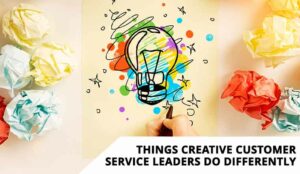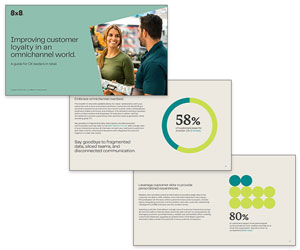Investing in customer obsession yields a 700%-plus return on investment over 12 years, according to Forrester—an incredible ROI. How do organizations achieve such gains?
Customer-obsessed organizations distinguish themselves with their unwavering commitment to putting the customer at the centre of everything they do.
These companies understand that meeting and exceeding customer expectations is key to their success. 8×8 advisor John Combs notes, “We think and do what is best for the customer first, before we think how they can benefit us as individuals or as the company.”
With that mantra in mind, here are eight traits that customer-obsessed organizations share:
1. Customer-Centric Culture:
Customer-obsessed organizations instill a customer-first mindset throughout their entire workforce. They foster a culture that values customer satisfaction and prioritizes delivering not just expected, but exceptional, experiences.
Customer-centric cultures are supported from the top down and permeate through all levels of the organization, influencing decision-making and driving continuous improvement.
An incredible example of this is Sweetwater Sound. “Where we differentiate ourselves is on our fanatical degree of customer experience,” says JP Eagleson, Sweetwater’s vice-president of IT.
2. Deep Understanding of Customer Needs:
Organizations that are customer-obsessed have invested significant effort in understanding their customers at a granular level.
They conduct extensive research, collect data, and employ analytical tools to gain insights into customer preferences, pain points, and desires.
By understanding their customers’ needs, they can develop products, services, and experiences that truly resonate and reduce points of friction.
UK-headquartered Agilisys uses 8×8’s Customer Experience Analytics to gain insight into every step of the customer journey.
Notes Customer Services Design Analyst Ian Palmer, “We look at how people are moving through the IVR, so we can discuss with clients how to redraw their IVRs and continually improve their customer service.
“We work together to make sure that the flow is dropping people into the right places in the system based on which number they’re dialing, taking away any barriers and removing the need for additional IVRs.”
3. Active Listening When It Comes to Customer Feedback:
Customer-obsessed organizations actively seek out and continuously listen and adjust based on customer feedback. They establish various channels for customers to provide input including surveys, feedback forms, social media, and customer service engagement.
They leverage this feedback to identify areas for improvement and make data-driven decisions that enhance the customer experience.
Trek Bicycle Corporation is a phenomenal example of listening to the customer to ensure they are being put first in everything the company does.
4. Frontline Employee Empowerment:
Recognizing the critical role that frontline (and increasing all) employees play in customer experience, customer-obsessed organizations empower their staff to communicate and collaborate effectively across the organization.
They provide the training, tools, and other resources necessary to address customer questions and needs effectively. These organizations trust their employees to make decisions that prioritize customer satisfaction, enabling them to deliver tailored, timely, exceptional service.
From its managers to switchboard operators, the Princess Alexandra Hospital NHS Trust enables its employees with the tools, training, and resilient technology they need to handle hundreds of thousands of calls per month with a personalized experience for every patient.
5. Continuous Innovation Based on Customer Insights:
Customer-obsessed organizations leverage insights across the customer journey to drive innovation. They use the data they collect to identify emerging trends, anticipate customer demands, and develop new products and services that exceed expectations.
These organizations foster a culture of innovation, encouraging employees to think creatively to deliver value to customers.
The Kansas City Royals go above and beyond for their customers (their fans and season-ticket holders) by leveraging speech analytics to pull valuable insights from structured and unstructured data.
“The platform helps us better understand our customers and provide more value in each of our interactions with them,” says the Royals’ Senior Director of Technology, Brian Himstedt.
6. Increasingly Seamless Omnichannel Experiences:
In today’s interconnected world, customer-obsessed organizations understand the importance of delivering seamless experiences across multiple channels.
They provide a consistent experience across both physical and digital touchpoints. This omnichannel approach ensures that customers can engage with the organization effortlessly, regardless of the channel they choose.
Cape Air is a soaring example of a company that strives to provide an exceptional customer experience on any channel.
Cape Air’s Director of contact centres Tom Rocharz notes, “Sometimes if you reach out to a travel agency or carrier, you have no choice but to work with an automated system or have to pay a surcharge fee to speak with a live agent.
“Cape Air has never done that. It takes a lot of resources and time to give that level of attention to everybody, but it’s something that’s very important to us.”
To raise the bar even further, Cape Air is deploying Intelligent Customer Assistant (ICA), a powerful, user-friendly conversational AI solution that enables businesses to create simple to complex self-service experiences across all channels.
7. Proactive Anticipation and Resolution of Customer Needs:
Rather than simply responding to customer requests, customer-obsessed organizations take a proactive approach.
They use data and analytics to anticipate customer needs and provide solutions before customers even realize they require them. By staying one step ahead, these organizations can surprise and delight customers, fostering long-term loyalty and advocacy.
8. Culture of Continuous Learning and Improvement:
Customer-obsessed organizations strive to always be improving their customer experience. They regularly measure and track key performance indicators related to customer satisfaction and use these insights to drive iterative enhancements.
These organizations encourage experimentation, learn from their successes and challenges, and adapt their strategies to meet evolving expectations.
The University of Worcester is a prime example of this, from a focus on reducing call wait times during the university’s busiest periods to giving students new and preferred channels for support.
This blog post has been re-published by kind permission of 8x8 – View the Original Article
For more information about 8x8 - visit the 8x8 Website
Call Centre Helper is not responsible for the content of these guest blog posts. The opinions expressed in this article are those of the author, and do not necessarily reflect those of Call Centre Helper.
Author: 8x8
Published On: 13th Jul 2023 - Last modified: 18th Jul 2023
Read more about - Guest Blogs, 8x8






 8x8 is transforming the future of business communications as a leading Software-as-a-Service provider of voice, video, chat, contact centre, and enterprise-class API solutions, powered by one global cloud communications platform.
8x8 is transforming the future of business communications as a leading Software-as-a-Service provider of voice, video, chat, contact centre, and enterprise-class API solutions, powered by one global cloud communications platform. 










